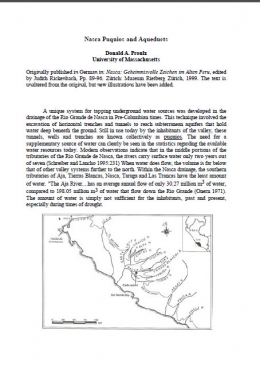Nasca Puquios and Aqueducts
Publisher:
University of Massachusetts
A unique system for tapping underground water sources was developed in the drainage of the Rio Grande de Nasca in Pre-Columbian times. This technique involved the excavation of horizontal trenches and tunnels to reach subterranean aquifers that hold water deep beneath the ground. Still in use today by the inhabitants of the valley, these tunnels, wells and trenches are known collectively as puquios. The need for a supplementary source of water can clearly be seen in the statistics regarding the available water resources today. Modern observations indicate that in the middle portions of the tributaries of the Rio Grande de Nasca, the rivers carry surface water only two years out of seven (Schreiber and Lancho 1995:231) When water does flow, the volume is far below that of other valley systems further to the north. Within the Nasca drainage, the southern tributaries of Aja, Tierras Blancas, Nasca, Taruga and Las Trancas have the least amount of water. "The Aja River....has an average annual flow of only 30.27 million m3 of water, compared to 198.05 million m3 of water that flow down the Rio Grande (Onern 1971). The amount of water is simply not sufficient for the inhabitants, past and present, especially during times of drought.
Work regions:
Publication Type:
Publication language:
English

Files:
